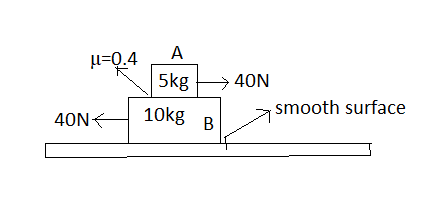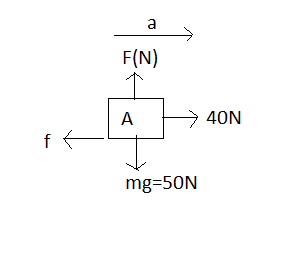
Two blocks (A) and (B) are arranged on a smooth horizontal plane as shown in figure. If two forces of equal magnitude act on the block (A) and block (B). If the ratio of acceleration of block (A) to block (B) is $n:1$ (where n is an integer). Then find$n$. ($g = 10m/{s^2}$)

(A) $1$
(B) $2$
(C) $\dfrac{1}{2}$
(D) $0$
Answer
217.5k+ views
Hint To make it simpler to understand and solve this problem we first draw the free body diagrams of both the blocks (A) and (B) by isolating the blocks from one another. After drawing the free body diagrams of both the blocks we use friction formula and find the friction force acting on both the blocks. We add all the forces acting on each block and solve for acceleration. We then equate the ratio of acceleration given in the question to the actual ratio of acceleration in both the blocks to find n.
Formula used Friction force $f = \mu {F_N}$
Here,
Friction force is represented by $f$
Coefficient of friction is represented by $\mu $
Normal force is represented by ${F_N}$
Complete Step by step solution
Let us take block (A) first to solve
Free body diagram of block (A) is

The normal force acting on block (A) is
${F_{N - A}} = {m_A}g = 50N$
From the formula of friction force
$f = \mu {F_{N - A}} = 0.4 \times 50 = 20N$
The sum of forces acting on block (A) in horizontal direction,
${m_A}{a_A} = 40 - f$
Acceleration of block (A) is
$ {a_A} = \dfrac{{40 - f}}{{{m_a}}} $
$ {a_A} = \dfrac{{40 - 20}}{5} = 4m/{s^2} $
Here,
Friction force is represented by $f$
Normal force of (A) is represented by ${F_{N - A}}$
Mass of (A) is ${m_A}$
Acceleration of (A) is ${a_A}$
Taking block (B) under consideration
Friction force acting on block (B) will be the same as (A) because the friction force acting is between the surface of block (A) and block (B) with the weight of block (A) as the normal force.
${f_A} = {f_B} = f=20N$
The sum of all the forces acting on block (B) in the horizontal direction,
${m_B}{a_B} = 40 - f$
Acceleration of block (B) is equal to
${a_B} = \dfrac{{40 - f}}{{{m_B}}} $
$ {a_B} = \dfrac{{40 - 20}}{{10}} = 2m/{s^2} $
Here,
Friction force is represented by $f$
Mass of (B) is ${m_B}$
Acceleration of (B) is ${a_B}$
From the question ratio of accelerations is
$\dfrac{{{a_A}}}{{{a_B}}} = n:1 $
$ \dfrac{{{a_A}}}{{{a_B}}} = \dfrac{4}{2} = \dfrac{2}{1} = \dfrac{n}{1} $
Hence $n$ is equal to $2$
Option (B) is the correct answer
Note There is no friction force between the surface of block (B) and the horizontal plane because the horizontal plane is smooth. Hence the friction force is zero between these two surfaces. The sign conventions taken in the above question are positive for right and upward directions, and negative for left and downward directions.
Formula used Friction force $f = \mu {F_N}$
Here,
Friction force is represented by $f$
Coefficient of friction is represented by $\mu $
Normal force is represented by ${F_N}$
Complete Step by step solution
Let us take block (A) first to solve
Free body diagram of block (A) is

The normal force acting on block (A) is
${F_{N - A}} = {m_A}g = 50N$
From the formula of friction force
$f = \mu {F_{N - A}} = 0.4 \times 50 = 20N$
The sum of forces acting on block (A) in horizontal direction,
${m_A}{a_A} = 40 - f$
Acceleration of block (A) is
$ {a_A} = \dfrac{{40 - f}}{{{m_a}}} $
$ {a_A} = \dfrac{{40 - 20}}{5} = 4m/{s^2} $
Here,
Friction force is represented by $f$
Normal force of (A) is represented by ${F_{N - A}}$
Mass of (A) is ${m_A}$
Acceleration of (A) is ${a_A}$
Taking block (B) under consideration
Friction force acting on block (B) will be the same as (A) because the friction force acting is between the surface of block (A) and block (B) with the weight of block (A) as the normal force.
${f_A} = {f_B} = f=20N$
The sum of all the forces acting on block (B) in the horizontal direction,
${m_B}{a_B} = 40 - f$
Acceleration of block (B) is equal to
${a_B} = \dfrac{{40 - f}}{{{m_B}}} $
$ {a_B} = \dfrac{{40 - 20}}{{10}} = 2m/{s^2} $
Here,
Friction force is represented by $f$
Mass of (B) is ${m_B}$
Acceleration of (B) is ${a_B}$
From the question ratio of accelerations is
$\dfrac{{{a_A}}}{{{a_B}}} = n:1 $
$ \dfrac{{{a_A}}}{{{a_B}}} = \dfrac{4}{2} = \dfrac{2}{1} = \dfrac{n}{1} $
Hence $n$ is equal to $2$
Option (B) is the correct answer
Note There is no friction force between the surface of block (B) and the horizontal plane because the horizontal plane is smooth. Hence the friction force is zero between these two surfaces. The sign conventions taken in the above question are positive for right and upward directions, and negative for left and downward directions.
Recently Updated Pages
Elastic Collision in Two Dimensions Explained Simply

Elastic Collisions in One Dimension Explained

Electric Field Due to a Uniformly Charged Ring Explained

Electric Field of Infinite Line Charge and Cylinders Explained

Electric Flux and Area Vector Explained Simply

Electric Field of a Charged Spherical Shell Explained

Trending doubts
JEE Main 2026: Application Form Open, Exam Dates, Syllabus, Eligibility & Question Papers

Derivation of Equation of Trajectory Explained for Students

Hybridisation in Chemistry – Concept, Types & Applications

Understanding the Angle of Deviation in a Prism

Understanding Collisions: Types and Examples for Students

How to Convert a Galvanometer into an Ammeter or Voltmeter

Other Pages
JEE Advanced Marks vs Ranks 2025: Understanding Category-wise Qualifying Marks and Previous Year Cut-offs

Units And Measurements Class 11 Physics Chapter 1 CBSE Notes - 2025-26

NCERT Solutions For Class 11 Physics Chapter 8 Mechanical Properties Of Solids

Motion in a Straight Line Class 11 Physics Chapter 2 CBSE Notes - 2025-26

NCERT Solutions for Class 11 Physics Chapter 7 Gravitation 2025-26

Understanding Atomic Structure for Beginners




